Origins of the Korean Jindo Dog
The Korean Jindo dog is an old breed that originates from an island called Jindo, which is located off the southwest coast of South Korea.
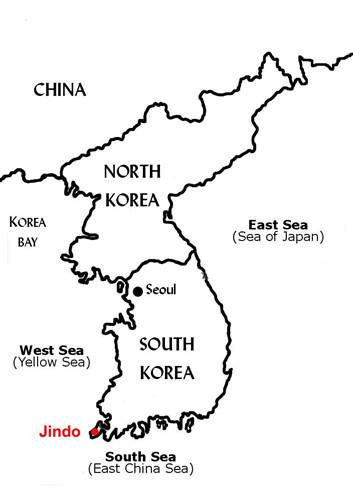
Modern Day Korea |
There are no written records about how the first dogs arrived on the island of Jindo. There are several theories that have been presented in the past:
1. The Jindo dog is descended from a dog that washed ashore from a wrecked Chinese merchant ship. During the Koryeo Kingdom, a major sea route was located in the Jindo strait that traders would use when traveling between China, Korea and Japan. This would of happened between 960 - 1270 A.D.
2. The Jindo dog is a descendant of Mongolian dogs brought to Korea. In 1270 A.D., Mongols invaded Jindo, took people from Jindo back to their country, enslaved them, and released them back to Jindo after 3 years. When the people returned, they brought back Mongolian dogs which became the predecessor of the Jindo dog.
3. The Jindo dog is a descendant of watch dogs brought over from Mongolia, to watch over Mongolian military horses at a ranch in Jindo county during the early Joseon dynasty. (Joseon Dynasty 1392 - 1910 A.D.)
4. The Jindo dog is descended from a stray puppy which was raised by a wolf on Mt. Yeogwi and cross-bred.
Currently, the most widely held theory is that the Jindo dog originated from the dogs already indigeneous to the Korean pennisula thousands of years ago.
Korean spitz-type dogs were found thoughout the Korean pennisula although only the populations that had kept a high degree of isolation from foreign dogs and had avoided extermination from wars have maintained their identity in modern times.
The dogs from Poongsan survived as a breed because they were located high in the Baiku Mountains which have a 6,000 ft elevation. The dogs from Jindo and Chejudo were protected by their island isolation.
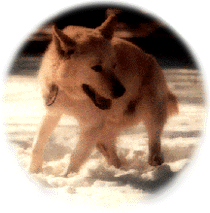
Poongsan Dog |
Less fortunate were the Bool gae, Gaulchae, Daeng kyun and a few others which are now struggling with near extinction or have been outcrossed to increase their numbers.
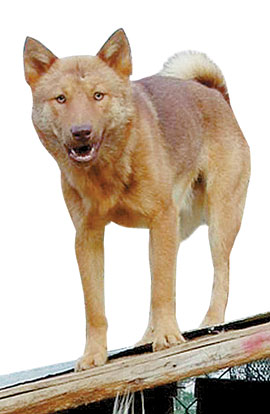
Bool gae |
The proto-type of the Korean spitz-type dogs may hail back to the late Stone Ages, but the earliest records of Korean hunting dogs were written during the Three Kingdoms era. During this period, the Goguryeo Kingdom (37 BC - 668 AD) dominated over the two other Kingdoms, Baekje and Silla.
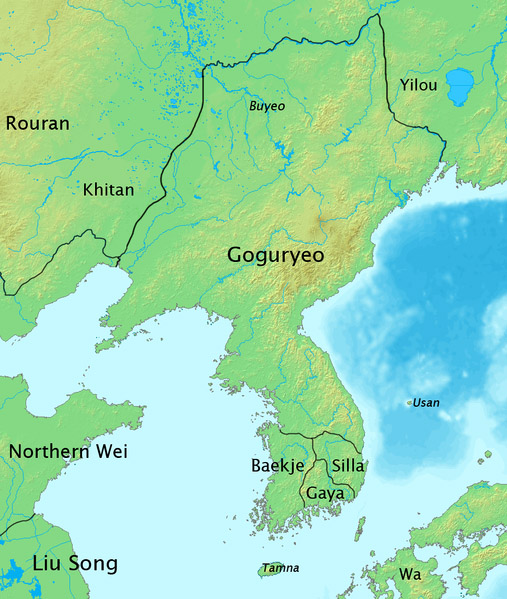
Height of Goguryeo influence, 391-531 AD
|
The Goguryeo Kingdom extended from the Korean pennisula to southern Manchuria and southern Russia Maritime providence. It is likely that Mongolian and Russian region dogs contributed to Korean dogs because of Goguryeo's expanded borders.
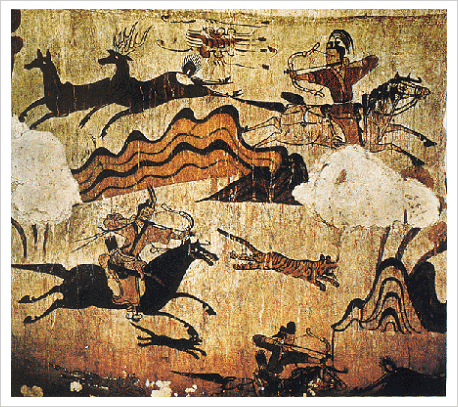
A Goguryeo tomb mural depicting a hunting scene.
Dark dog is located under the dark horse.
|
Japanese documents in the 5th century recorded how a hawk was tamed for the first time in the Baekje Kingdom, and how three years later, some hawks and hunting dogs were taken from Baekje and introduced to the Japanese. Additional documents mention that horses, mules, and hunting dogs were shipped to Japan as a form of tribute up to 685 A.D.
With this evidence, it is safe to assume that the Korean hunting dogs existed at least 1500 years ago. Under the view that the Jindo dog is part of the family of Korean hunting dogs, the Jindo dog is often referred to as being thousands of years old as well.
The Jindo dog developed certain character traits as it developed further on the island. They are noted as having strong spirit, which was encouraged due to the difficult living conditions on the island. Many of their owners could not provide more than meager scrapes to their dogs and so the dogs had to basically hunt for their own food and sometimes their owner's food. Dogs roamed free on the island, and they retained many primitive traits in order to survive and thrive.
The Current Status of the Jindo
In Korea, the Jindo dog is designated as Republic of Korea Preservation of Cultural Assets Act No. 53 (or simply called Korea Natural Treasure #53). Dogs born on the island fall under the jurisdiction of Jindo County. The county holds bi-yearly evaluations of young dogs, is responsible for the protection of the dogs, and hosts the annual Jindo Island dog show. A research institute was created in 1999 for the study of the Jindo dog.
There is a large population of Jindo dogs that live outside of the island though. The mainland of Korea has a significant population, perhaps half of all Jindos in South Korea, and there are many Jindo dog organizations that strive to preserve the purity of the breed and promote the propagation of excellent dogs.
In the United States, the Jindo dog can usually be found in large Korean immigrant communities. Though the export of pure Jindo dogs was regulated under Korean laws, Korean immigrants and American servicemen have been bringing over Jindo dogs since the late 1980’s. Korean Jindo owners in Los Angeles, CA established a Jindo breed club in 1993 and started conducting shows in 1995. Jindo judges were flown from Korea to the US to judge these shows.
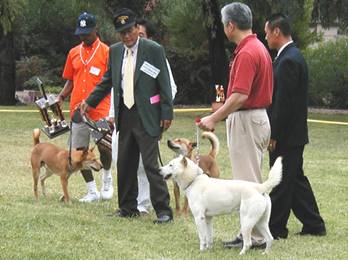
2005 Jindo Dog Association of America show
In 1998, the United Kennel Club, the second largest dog registry in the U.S., recognized the Jindo. An assortment of rare breed organizations also recognizes the breed. For a brief time in the 1990's, Jindos competed in American Rare Breed Association shows before their Korean owners lost interest in showing in this Western-style venue.
In the United Kingdom, there were a few Jindo dogs brought over by Korean immigrants as well, but only the Jindo Island dogs from the 2002 import group are considered official. At this time, only they and their descendants can be registered with The Kennel Club. The Jindo breed was recognized by The Kennel Club in 2005.
On a much grander, international scale, the Korean Jindo received full breed recognition in 2005 by the Federation of Cynologique Internationale as FCI Standard No. 334. They were formally approved at the World Dog Show held in Argentina in July 2005.
It's been asked many times, when will the Jindo be recognized by the American Kennel Club in the United States? When will the Jindo be proudly shown next to the Japanese Shiba at the Westminster Kennel Club dog show?
At this time, it is considered very unwise by both knowledgeable Koreans and Americans to pursue AKC recognition when there are no safeguards and no strong parent club in place to offset the inevitable negative repercussions of widely popularizing the breed. Some of the negative repercussions are..
-splits in the breed (ie. American-style Akita vs. Japanese-style Akita),
-the loss of breed abilities in favor of showmanship (ie. dysplasic German Shepherds who can't scale a wall, straight-legged Fox terriers unable to work tunnels, etc.)
-the loss of genetic diversity/health due to the prevaling breeding practices in the show ring (ie. closed stud books, popular sire effect, inbreeding, exclusion of dogs who don't follow the current fad, etc.),
-the rush to produce puppies before their parents are old enough to receive health tests,
-unscrupulous breeders exploiting the breed for money, and
-lack of breed education for owners, breeders, judges, and the general public.






